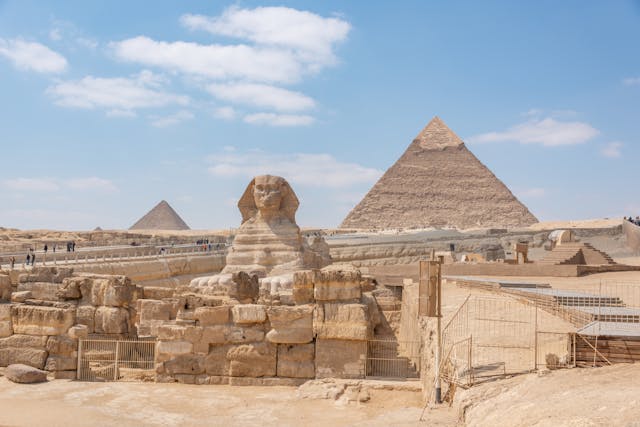Disclosure Statement: Durand Financial Services Pty Ltd and its advisers are authorised representatives of Fortnum Private Wealth Ltd ABN 54 139 889 535 AFSL 357306. General Advice Warning: The information contained within this website does not consider your personal circumstances and is of a general nature only. You should not act on it without first obtaining professional financial advice specific to your circumstances.
The concept of the “Wonders of the World” has evolved over time, with various lists compiled to encompass the world’s most spectacular natural sights and human-built structures.
The traditional list of the Ancient Wonders of the World highlights the extraordinary creations of classical antiquity, but modern lists have been created to include more recent and natural wonders.
Here’s an in-depth look at a combined list, often referred to as the “Eight Wonders of the World,” encompassing both ancient marvels and modern masterpieces:
- Great Pyramid of Giza (Egypt) – The only one of the original Seven Wonders of the Ancient World still in existence. The pyramid was constructed as a tomb for the Egyptian Pharaoh Khufu (Cheops in Greek) around 2580–2560 BC. It originally stood at 146.6 meters (481 feet) but now is slightly shorter due to the loss of the outer casing stones. Its construction is a testament to the architectural skill and ingenuity of the ancient Egyptians.
- Hanging Gardens of Babylon (Iraq) – Often described as a remarkable feat of engineering with lush greenery and exotic plants hanging above the ground, the existence and actual location of the Gardens remain one of history’s tantalizing mysteries. They were said to be built in the ancient city-state of Babylon, near present-day Baghdad in Iraq, around 600 BC but there is no definitive archaeological evidence of their existence.
- Statue of Zeus at Olympia (Greece) – A monumental statue of the god Zeus, crafted by the renowned sculptor Phidias around 435 BC in Olympia, Greece. Made of ivory and gold, the statue stood over 12 meters (39 feet) tall, symbolizing the power and might of the king of the gods. The statue was lost to history, and its precise appearance is known only from ancient descriptions and representations on coins.
- Temple of Artemis at Ephesus (Turkey) – A magnificent temple dedicated to the goddess Artemis, located in Ephesus (near the modern town of Selçuk in present-day Turkey). It was completed around 550 BC and was renowned for its grandeur and splendid architecture, including 127 marble columns each standing 18 meters (60 feet) high. It was destroyed and rebuilt several times before its final destruction in 401 AD.
- Mausoleum at Halicarnassus (Turkey) – An elaborate tomb built for Mausolus, a satrap of the Persian Empire, and Artemisia II of Caria, his sister and wife, around 350 BC. The structure stood approximately 45 meters (148 feet) in height and was adorned with sculptural reliefs. Its grand design and ornate decorations gave rise to the term “mausoleum,” used for grand tombs.
- Colossus of Rhodes (Greece) – A gigantic statue of the sun god Helios, erected in the city of Rhodes between 292 and 280 BC. It was approximately 33 meters (108 feet) high, making it one of the tallest statues of the ancient world. The Colossus stood for only 56 years before it was destroyed by an earthquake. The remains were a tourist attraction for centuries but eventually disappeared.
- Lighthouse of Alexandria (Egypt) – Also known as the Pharos of Alexandria, it was a towering lighthouse built by the Ptolemaic Kingdom between 280 and 247 BC on the island of Pharos in Alexandria, Egypt. It was one of the tallest man-made structures in the world for many centuries, standing approximately 100 meters (330 feet) tall. The lighthouse was severely damaged by earthquakes and eventually became an abandoned ruin.
- Great Wall of China (China) – Often celebrated as the “Eighth Wonder of the World,” this impressive fortification stretches over 21,000 kilometres (13,000 miles) and was built, rebuilt, and maintained between the 5th century BC and the 16th century to protect the northern borders of the Chinese Empire from various nomadic groups. The Great Wall is not a continuous line but a collection of walls and fortifications.
These wonders demonstrate human creativity, architectural prowess, and the desire to memorialize cultural and religious beliefs in stone, metal, and gardens. Each wonder has its own unique story, cultural significance, and historical context, capturing the imagination of people throughout history and across the globe.
If this article has inspired you to think about your own unique situation and, more importantly, what you and your family are going through right now, please contact your advice professional.
This information does not take into account the objectives, financial situation or needs of any person. Before making a decision, you should consider whether it is appropriate in light of your particular objectives, financial situation or needs.
(Feedsy Exclusive)





